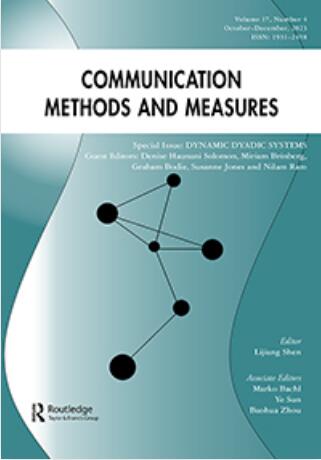Training Versus Responsiveness in Supportive Interactions Employing Confederates: A Dynamic Dyadic Systems Approach
IF 3.7
1区 文学
Q1 COMMUNICATION
引用次数: 1
Abstract
ABSTRACT The cognitive-emotional theory of esteem support messages (CETESM) posits that esteem support can enhance recipients’ state self-esteem after an acute threat. To test the CETESM and other supportive communication theories, researchers have conducted experiments employing trained confederates who provide supportive messages of varying quality to naïve disclosers. Manipulation checks of confederate fidelity to conditions are typically conducted at the level of the entire conversation. However, conversation-level checks fail to provide critical information about what happens in interactants’ turns at talk. The present report reanalyzes data from a study framed by the CETESM in which confederates were trained to enact four esteem support message styles when interacting with a naïve discloser. Engaging in turn-based coding and employing analytical techniques such as configural frequency analysis (CFA), we test hypotheses and research questions regarding: (1) how confederate turns correspond to their assigned condition; (2) the nature of discloser turns in esteem support interactions with confederates; (3) the nature of discloser-to-confederate turn transitions; and (4) discloser-to-confederate turn transitions associated with key outcomes for disclosers. Results indicate that while many confederate turns were consistent with their assigned condition, interesting deviations occurred in response to discloser turns, some of which were linked to outcomes.训练与反应:一个动态双元系统方法
本文章由计算机程序翻译,如有差异,请以英文原文为准。
求助全文
约1分钟内获得全文
求助全文
来源期刊

Communication Methods and Measures
COMMUNICATION-
CiteScore
21.10
自引率
1.80%
发文量
9
期刊介绍:
Communication Methods and Measures aims to achieve several goals in the field of communication research. Firstly, it aims to bring attention to and showcase developments in both qualitative and quantitative research methodologies to communication scholars. This journal serves as a platform for researchers across the field to discuss and disseminate methodological tools and approaches.
Additionally, Communication Methods and Measures seeks to improve research design and analysis practices by offering suggestions for improvement. It aims to introduce new methods of measurement that are valuable to communication scientists or enhance existing methods. The journal encourages submissions that focus on methods for enhancing research design and theory testing, employing both quantitative and qualitative approaches.
Furthermore, the journal is open to articles devoted to exploring the epistemological aspects relevant to communication research methodologies. It welcomes well-written manuscripts that demonstrate the use of methods and articles that highlight the advantages of lesser-known or newer methods over those traditionally used in communication.
In summary, Communication Methods and Measures strives to advance the field of communication research by showcasing and discussing innovative methodologies, improving research practices, and introducing new measurement methods.
 求助内容:
求助内容: 应助结果提醒方式:
应助结果提醒方式:


